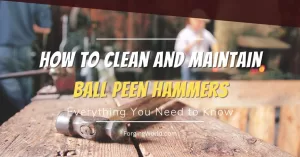Blacksmithing is a beautiful craft as long as if it is done safely and properly. When you are just starting with blacksmithing, chances are that you will make a lot of mistakes. I made a lot of mistakes in the past. This is why I decided to write this article, hoping you won’t make the same mistakes as I did.
These are some of the most dangerous blacksmithing mistakes which will people often make:
- Putting Your Thumb on the Hammers Handle During Striking
- Leaving Hot Metal Everywhere
- Starting with Advanced Projects
- Placing Your Working Piece at an Angle in the Forge
- Cutting or Grinding Without a Face Shield
- Wrong Hammering Technique
- Not Using Safety Glasses
- Wearing Gloves During Machinery work
- Not Having Proper Ventilation
- Keeping Forge Near Flammable Materials
- Not Wearing Ear Protection
- Setting the Improper Height of the Anvil
- Not Organized Workshop
- Wearing Polyester Clothing
Putting Your Thumb on the Hammers Handle During Striking
Since a hammer is one of the most used tools in blacksmithing, it is crucial to know how to properly hold it. Placing the thumb over the handle is one of the common mistakes, especially for beginners. Although it may not seem such a big deal at first, constant striking with your thumb over the handle will put tremendous stress on your wrist joint.
Carpal Tunnel Syndrome and Elbow Tendonitis are two of the most common injuries in blacksmithing, mainly caused by the wrong hammering technique. Putting your thumb over will drastically increase the chances of developing Carpal Tunnel Syndrome. Trust me, you don’t want to develop that. In case you have pain in the thumb area, check with your doctor as soon as possible before you develop chronic pain. Don’t take medical advice from the blacksmith.
To avoid that scenario, simply make a full grip around the handle. Not only you will minimize future injuries, but you will also have more energy during hammering. Placing the thumb on the handle is only recommended for fine work as you have more accuracy and control.
Leaving Hot Metal Everywhere
This one is surprisingly very common in blacksmithing. It even happens to experienced blacksmiths, not just to beginners. One of the most common places where people put their hot metal is over the anvil. I mean, not ideal at all. There are millions of different scenarios that can happen if a hot metal is left everywhere.
For example, you can walk by and accidentally touch it. It may not fall, but it will burn you. Or, it can easily fall on your foot. One more thing, don’t let the color of the metal fool you. Just because the material is not red doesn’t mean it is cold.
This happens mostly at the end of the work then you are tired and not thinking very clearly. Also, don’t leave your hot material near flammable materials, as it can easily catch fire.
Starting with Advanced Projects
This is one of the most common mistakes seen by beginners. Not everyone is willing to go through the proper process of becoming a blacksmithing expert. Most people today are thinking they can immediately make a $2000 Damascus blade. It simply does not work that way.
You have to start simple with easy projects, like making a chisel or nail. I understand the desire to make something special but remember that every blacksmithing expert also had to start somewhere. Completing a few simple projects will give you the required skills and confidence to move on to more advanced work.
Placing Your Working Piece at an Angle in the Forge
Again, this mistake is mostly done by beginner blacksmiths. Placing your metal at an angle in the forge will produce uneven heat which presents various problems. Uneven heat produces weak spots on the material. For example, if you place a knife at an angle in the forge, there is a high chance of creating weak spots.
These formed weak spots in the steel can cause your blade to crack which is something you definitely don’t want. Keep it nice and level in the forge. If you are using coal, place it on top of the firepot, not on top of the coal. On the other hand, if you are using a gas forge, simply place it in the middle of the forge.
Cutting or Grinding Without a Face Shield
A face shield is a must during any operations which produce metal sparks. Yet, a lot of people do not frequently use it. As I said by using the safety glasses, the same concepts should be transferred here. Flying bits of material, coal, or metal spark can hit you right in the eye, so wearing it will greatly reduce the likelihood of that scenario.
Wrong Hammering Technique
A hammer is to a blacksmith the same as a brush is to a painter. It is the tool you will use the most in the shop. Because of that, it is very important to know how to properly use it. When it comes to striking the hammer, it is all about the effective use of the shoulder, elbow, and wrist joints.
With improper technique, you will increase the chances of getting injured. Not only that, but you will also lose a lot of energy as you don’t use your body effectively. Before starting, consider the weight of the hammer and the thickness of the handle. If you are a beginner, a big, heavy hammer (usually above 3 pounds) with a thick handle is the worst thing you can use. Now, keep in mind that nobody has the same strength level. You may use a 3-pound hammer without a problem while your friend can.
First, your grip should be loose, rather than tight. When you want to make power strikes, you should grip the hammer near the end of the handle. Contrarily, when you need more precision and control, grip it near the head. Your stand is also very important. Feet should be shoulders width apart with one leg front and one back. The knees should be slightly bent.
When you are swinging, don’t let your hammer go above your ears as this can put unnecessary stress on the shoulder joint. When you come down, your hammer should be parallel to the face of the anvil. Of course, if you are working some specialized work, your hammer will come down at an angle. Note that, your muscle should not be flexed during swinging because you will lose more energy.
Not Using Safety Glasses
I would say that this is the most dangerous mistake that you can make in the blacksmithing shop. I mean, if you lose your sight, you are done with blacksmithing. Using safety glasses is the simplest thing you can do to protect your eyes. Still, some people think they are not a “real man” if they are using it.
There are a lot of cases where people injured their eyes and almost lost their sight completely. Many experts say that 90% of these injuries could be prevented with proper eye protection. Be responsible for wearing safety glasses, not egoistic. This is definitely not the time when you should be lifting up your ego. Also, safety glasses are cheap and easily available.
Wearing Gloves During Machinery work
This one may sound weird to some people who think that you should always wear gloves in the blacksmithing shop. Not only it is wrong, but it can be very dangerous. For example, you should never wear any type of gloves during machinery work, especially when working with a drill press or lathe.
You can easily snag the finger at the cutter or drill bits that can rip your skin off and even tear your finger off. This is also common when making some type of blade. This also falls among the most dangerous blacksmithing injuries, so don’t forget to remove gloves before working with this type of machine.
Not Having Proper Ventilation
If you don’t have proper ventilation in your workshop, don’t start working until you do. There are many reasons for that. Either if you working with a coal forge or a gas forge, both of them require proper ventilation. If you are working outside, it is not a problem, but if you work inside, be sure to make enough airflow in the shop.
Coal produces sulfur whereas gas forge produces carbon monoxide. Both are highly dangerous to inhale. Inhaling coal gases may harm your health in the long run but carbon monoxide is instantly dangerous. This is why you should always have some carbon monoxide detector somewhere in your workshop.
Make sure you have at least one window in your workshop, although the more you have, the better. Also, you can place a ventilator behind the forge for better airflow. If you are using coal or charcoal, it is very important to have a chimney that will take out toxic gases from the shop.
Keeping Forge Near Flammable Materials
This one is vital to mention. If your forge is near flammable materials, you can easily burn your whole shop. Two minutes away from the forge is enough for a catastrophe to happen. During the forging process, many bits of coal or charcoal can fly in the air. For example, having anything made from wood is a big mistake to have near the forge.
Fire occurs with 3 basic elements including fuel, oxygen, and heat. If you remove one of the elements, the fire will go out. So, removing the flammable materials (fuel) away from the forge will make your shop a considerably safer place to work in. Also, always have a bucket of water or a fire extinguisher near the forge. If you are planning on using the fire extinguisher, be sure to check which one is right for your needs.
Not Wearing Ear Protection
It is not uncommon to see some older blacksmiths with impaired hearing. As you know, blacksmithing is a very loud craft. The harmful noise level for people is beyond 85 decibels which striking an anvil usually exceeds every time. Of course, you will not become deaf suddenly but over time there is a high chance of developing hearing loss.
This is why you always want to wear some type of ear protection during work. You have two basic choices when it comes to ear protection; earmuffs and earplugs. Both of them have their advantages and disadvantages. Your decision will depend on the noise level, appropriateness, and comfort. In some extreme cases, both of them are used.
The most important thing is to have at least some type of ear protection. Remember, blacksmithing can be either a fun hobby or a professional career. Both of them greatly depend on your health.
Setting the Improper Height of the Anvil
You may not immediately feel discomfort if you set the wrong anvil height, but after some time (possibly after only a day or two) you will start to feel discomfort. This is because, when you strike the anvil which is either too low or too high, it causes additional and unnecessary stress on your body. Shoulder, wrists, elbow and are always most impacted during blacksmithing, but if your anvil is set too low, your lower back starts to be negatively stressed.
Setting your anvil at the proper height will drastically reduce potential lower back pain as you will have to make the body posture compensation. Setting the anvil too low forces you to fully extend your elbow while if the anvil is too high, your shoulders will most likely be hurt. Also, the fewer strikes to finish the job, the better, as you will have more energy. Except for being efficient with energy, you will also be much more precise which is very important for small projects.
For instance, if your anvil is set wrong, the hammer will strike at an angle that will create dents during the work.
To find your ideal height of the anvil, stand by the side of the anvil with your feet’ normal width apart. If you are right-handed, stand by your left side. Now, make a fist with your right hand (hammering hand). Knuckles will determine the right height of the anvil.
Not Organized Workshop
Before we analyze this mistake, it is important to explain, what does it even mean to have not organized shop? Well, one of the most important characteristics of a well-organized blacksmithing shop is that every tool has its own place. There is nothing worse than holding a hot piece of metal and suddenly you forgot where your hammer is.
Also, the equipment layout is very important. For example, an anvil should always be close to the forge. These two are the heart of every blacksmith’s shop where the action takes place the most. For the right-handed person, the ideal position is forge being on your left and an anvil on your right. That way you can easily take out your hot piece from the forge and place it on the anvil.
The distance between the forge and the anvil will vary, mostly depending on the length of the stock. If you frequently work with long stock, place your anvil further from the forge. Contrarily, if you mostly make small projects, the ideal distance between the two is somewhere between 4-6 feet (1.2-1.8m). We already mentioned keeping the forge near flammable materials so I will not explain it again.
There is much more to this topic, so in the near future, we will write an article on how to properly organized your blacksmithing workshop.
Wearing Polyester Clothing
You may be wondering; What does it matter what type of clothes I am wearing during work?
At first, it may seem even funny but it is not. Actually, it is far from funny. Except for being more breathable and natural, cotton is also less likely to catch fire. Namely, polyester clothing contains certain chemicals that can catch fire very easily. Cotton, on the other hand, is a natural material. I remember one day wearing a cheap polyester shirt during work at the coal forge.
As I was putting a hot piece of metal in the forge, one tiny piece of coal popped out on the shirt. Until I threw my shirt off, I was already burned. This was my first and I hope my last burn in the shop. Although cotton clothing is more expensive, I believe it is definitely worth it. Wearing cotton is one more safety precaution that can prevent newly-formed burns.
Conclusion
These are only some of the mistakes that blacksmiths do. Keep in mind that there are many more of them but the most important thing is to use them as a guide for moving forward. There is no single blacksmith who didn’t make a mistake, so I’m pretty sure you are not the one who also won’t. Keep working and keep improving.



